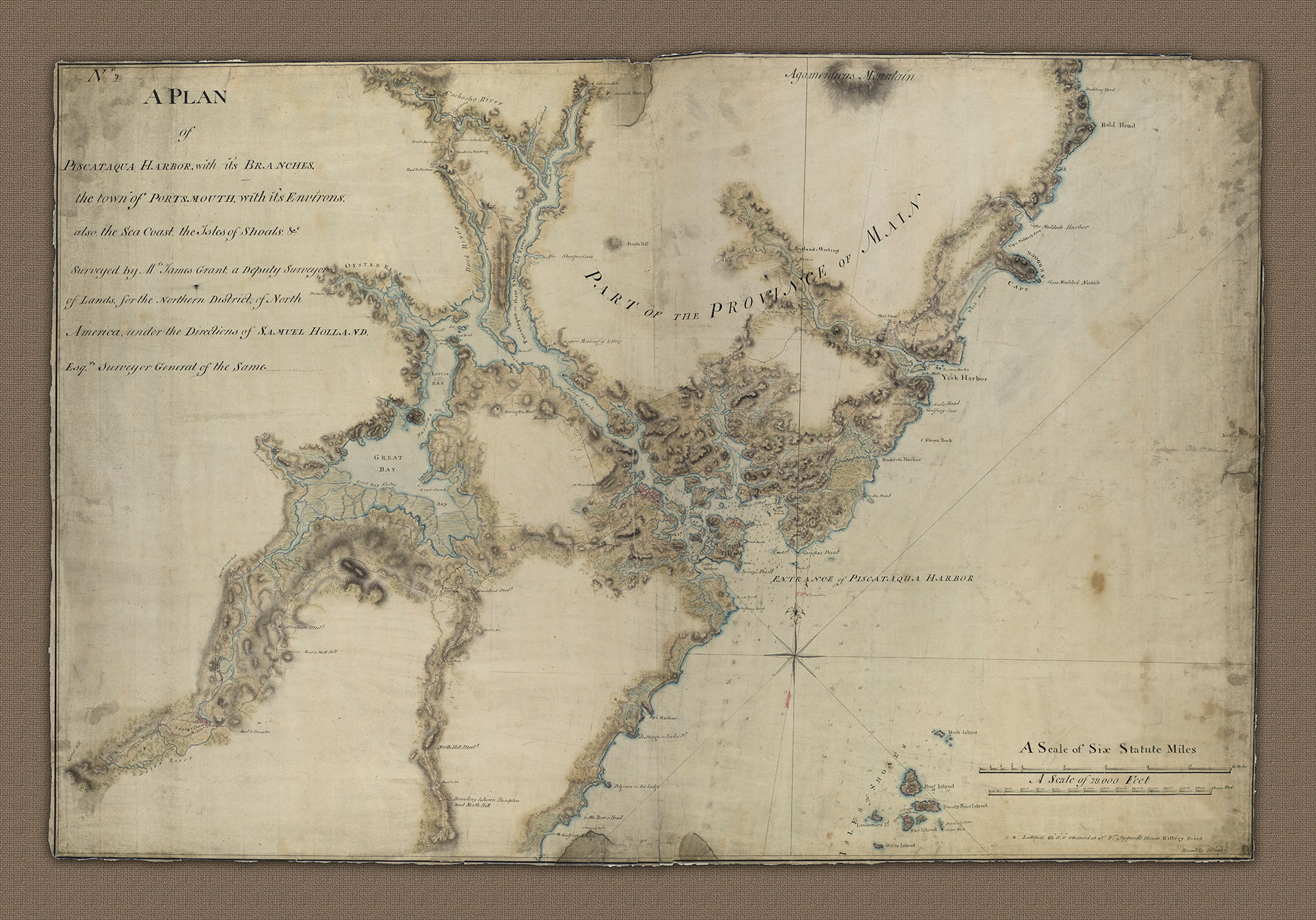
A110 - A plan of Piscataqua Harbour, with its branch of the Town of Portsmouth
This beautiful hand-drawn plan of Piscataqua Harbor and the town of Portsmouth is drawn and coloured to show land features such as roads, settlements, individual dwellings and buildings and relief as well as sea features including soundings and navigational hazards.
c1773
- Lieuts. James Grant and Thomas Wheeler
- h28.5" x w41"
- L
The inscription on the plan shows it was 'Surveyed by Mr James Grant, a Deputy Surveyor of Lands for the Northern District of North America under the Directions of Samuel Holland Esqr. Surveyor General of the same' and drawn by Thomas Wheeler. It is a familiar combination of names at this time as both Wheeler and Grant, working under Holland did a great deal of surveying and mapping along the north eastern seaboard at this time, including a good deal of military mapping (see Heritage Charts A104).
Portsmouth at the time was, to all intent and purpose, a British sea port with strong Loyalist sympathies. Not only was it a centre of commerce, it was important for it's ship building, lumber trade and fishing.
Importantly, the British also kept a large store of munitions in the poorly-defended Fort William and Mary on New Castle Island. At a time when the British were trying to stop the import of munitions into the colonies it understandably became a potential target for American sympathisers.
Portsmouth was also the adopted base of operation for Samuel Holland and his survey teams for the General Survey of the Northern District from 1770 through to 1774. Whilst stationed here the surveying teams completed their surveys of Nova Scotia, Maine and New England.
Three of Samuel Holland's team of surveyors; Thomas Wheeler, Charles Blaskowitz and James Grant are recorded as regular participants in the St. John's Masonic lodge in Portsmouth. Samuel Holland and Wheeler both appear in the Portsmouth Tax lists for the period , no doubt for their extended collaboration with Governor John Wentworth II in the mapping of New Hampshire.
When Paul Revere rode north from Boston on December 13th 1774 with news that the British were sending ships with Marines on-board to garrison the town, his alarm sent nearly 40 men from the area storming through the garrison the very next day, dragging down the British flag before disappearing into the winter snow with over 70 barrels of stolen gunpowder. The next day, further roused by word of Revere's message and the events of the day, a further group of men assembled in Portsmouth and returned to the fort to remove the remaining muskets and cannons. No lives were lost but these vital munitions, and the New Hampshire men themselves, later played a crucial role in the battle at Breed's ('Bunker') Hill on June 17th 1775.
The British presence in Portsmouth finally came to an end in August 1775. Portsmouth continued to be a major area of shipbuilding, and the celebrated American naval hero John Paul Jones (1747-92) spent time in Portsmouth on two separate occasions; the first in 1777 to oversee construction of the 'Ranger', and again in 1781-82 to oversee the building of the unfinished 74-gun "America" which eventually and, to Jones' dismay, was gifted to the French as a replacement for the loss of their ship-of-the-line, 'Magnifique' that had recently run aground near Boston.
In this chart Grant and Wheeler show considerable skill, both with their surveying and with their artistry, to present an informative and beautiful image. On a point of accuracy it is worth noting that, according to modern satellite technology, Kittery Point has latitude of 43°, 4', 59" degrees. In 1775 Grant, using only trigonometry and astrology, placed it at 43.5.0 degrees.
It should be noted that there is another survey of the Town and harbor in the hand of George Sproule from around the time still in existance (see Heritage Charts A126) along with a small survey of Portsmouth by Grant, held by the New Hampshire Historical Society (912.778b P853gr). The plan presented here is the copy which was used by Des Barres for the creation of the edition included in the Atlantic Neptune.
- A plan of Piscataqua Harbour, with its branch of the Town of Portsmouth


